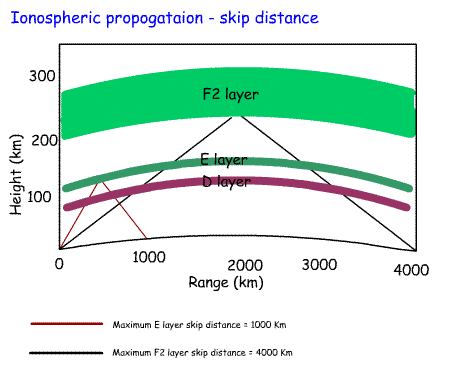
| ADVANCED LESSON 54 |  |
| LEARNING OBJECTIVES and NOTES | |
| Propagation -Ionosphere 1 | |
|
6b.1 Understand that the ionosphere comprises layers of ionised gases
and that the ionisation is caused by solar emissions including
ultra-violet radiation and charged solar particles. Recall the ionospheric layers (D, E, F1 and F2) and approximate heights. On the shortwave bands amateurs and some other radio users depend on the ionosphere to reflect radio signals at a much greater distance than could be achieved by goundwaves traveling along the Earth's surface. The ionosphere is made of layers of ionised gases. Ionisation is the process by which electrons are removed from atoms leaving free electrons and negative and positive charged atoms called ions. The ionisation is caused by emissions from the outer layer of the sun. For example charged solar particles and ultra-violet radiation The ionosphere is divided into several layers: The D layer at a height of 70 - 90km The E layer at a height of 115km The F1 layer 220 - 230km in daylight The F2 layer 350 - 450km in day light.This is the main reflecting layer for HF signals. It is higher in summer than in winter. It is higher at the peaks of the sun spot cycle. During the night time the F2 layer decreases in height and merges with the F1 layer to become the night time F layer at a height of 280-320km. |
 |
| 6b.2 Recall that the E layer can refract radio waves and that
sporadic-E is caused by areas of highly ionised gas that can refract
waves in the VHF band. Recall that the E layer supports single hops up to about 2000km. Another way in which VHF signals can travel further than normal is by refraction from the E layer when it is strongly ionised. This is called Sporadic E. In the UK this occurs mainly in summer. the E-layer allows single hops of up to about 2000km. NB Reflection means to bounce off a surface. This follows the rule that the angle of reflection is equal to the angle of incidence. For example if a wave meets a reflective surface at an angle of 45 degrees to the vertical it will be reflected at 45 degrees. When a wave enters a medium it slows down and bends slightly. This is called refraction. |
|
|
6b.3 Recall that the F2 layer provides the furthest refractions for HF
signals (about 4000km) and that the F layers combine at night. Recall that multiple hops permit world-wide propagation. The F2 layer is responsible for reflection of signals over the greatest distance - about 4000km. At night time the two F layers (F1 and F2) present is sunlight combine to form a single F layer. |
 |
|
6b.4 Understand how fading occurs and its effect on the received signal. Signals reflected from the ionosphere are subject to fading. The reason for this is that a signal may be reflected from two heights of the ionosphere. If these arrive at the receiving station in phase the signal will be strong. If the height of the reflecting layer changes slightly, the signals could arrive out of phase, causing the signal to be weaker. The same can occur when a signal arrives by ground wave and sky wave. If the skywave arrives in phase with the ground wave, the signals is strong. If the skywave changes length, the signal could be out of phase with the ground wave causing the signal to fade. Both of these cause QSB or fading in and out of the signal. This can be over a short or a long period of time. |